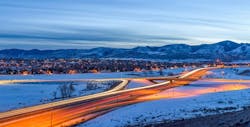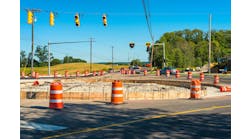Our mobility patterns are rapidly changing, given newly emerging vehicle categories, new transport business models, varied fuel sources, and driving that is automated by artificial intelligence (AI).
To keep up with these changes, DOTs need to not only understand the latest technologies, but transform their nimbleness and decision-making speed. They need to quickly perceive, analyze, and act on real-time data to keep innovating and progressing. To accomplish this level of agility, DOTs are using sensors, smart maps, and other forms of location intelligence.
Common locations
Location provides the common data element that links activity on roads, rails, trails, and runways.
“Every asset we manage from roads to bridges has not only a specific location, but also environmental conditions that affect performance,” said Joshua Laipply, Chief Engineer, Colorado Department of Transportation (CDOT). “Detailed mapping to capture many attributes is critical to maintaining, operating, and designing our roads.”
Building on Laipply’s statement, CDOT Chief Data Officer Barbara Cohn explained the importance of incorporating location information.
“Location intelligence is integral to a holistic understanding of the transportation network of the past, current, and our connected network of the future. Safety, congestion, mobility, sustainability, infrastructure—location data helps inform us of our surroundings with unprecedented accuracy.”
Apps to integrate operations
In establishing a Chief Data Office (CDO), CDOT recognized that modern departments of transportation are operating an increasingly complex data landscape. Advancing the vision of CDOT, Cohn, and her team are creating a strong and sustainable foundation to support future data needs.
CDOT is expanding the use of data and geospatial tools across the agency. This includes data pulled from a variety of siloed systems to create purpose-built applications. Applications include a Traffic Operations dashboard that ingests data feeds from Waze, HERE, traffic sensors, NOAA weather data, roadway sensors, CoTrip traveler alerts, and road condition information onto one interface. The dashboard provides key personnel with situational awareness and quick visibility into current conditions.
Another is the Statewide Transportation Improvement Program (STIP) viewer which extracts information from a variety of systems and identifies projects CDOT intends to fund over a four-year period. The interactive dashboard allows users to search by multiple criteria (e.g., funding program, source) and explore associated project information.
Other apps are much more targeted. An Avalanche dashboard displays and filters by location for snow events, road closures, and mitigation activity within a given time frame. A Night Inspection field mobile app gives crews the ability to record data on the reflectivity of roadway lighting and centerline visibility.
The team is also developing a dashboard to aggregate asset inventory and condition.
“Linking location with the power of visualization provides invaluable input for the discovery of trends, patterns, and insights,” Cohn said. “Visualizations can help distill increasing amounts of data, rendering complex data into images that maximize understanding.”
Quality and value
Leaders at CDOT recognize data as one of the department’s most strategic assets. But, having data is not the same as knowing what to do with it. Location-based apps provide one way for CDOT to turn raw data into actionable knowledge. Once data is exposed, it is no longer locked in silos. Data is seen in a whole new way, enhancing accuracy and generating insights.
“We’re operating within an exceptional innovative environment at CDOT. There’s a thirst for more information, for sharing information, for fostering collaborations, and creative and cooperative problem solving,” Cohn said. “We’re democratizing data. We’ve embarked on a journey to provide data as a service, data on demand from authoritative sources, capabilities for advanced analytics, predictive modeling, and more.”
Growing demands
Rapid population growth in Colorado drives more focus on traffic, congestion, and safety. In response, CDOT staff are increasing real-time data streams to improve operations and maintenance activities. By collecting historic data on incidents, as well as connected vehicle data such as hard braking and lane departure, the CDOT team can help identify which locations to address proactively.
CDOT is also deploying vehicle-to-everything (V2X) technologies, with initial deployment along the busy I-70 mountain corridor. The goals of creating this connected system—an "internet of roads"—is to provide drivers and traffic managers real-time information about road conditions such as traffic delays, icy conditions, and crashes through continuous and automatic communications between individual vehicles and roadside infrastructure. It is to provide more reliable travel times and, eventually, the ability to communicate with self-driving cars.
“We’re headed toward the internet of roads that will be able to communicate,” Laipply said. “V2X will provide the ultimate situational awareness, with highly accurate geolocated travel information, localized weather data, faster emergency response times, enhanced maintenance decision support, and more.”
CDOT is looking across all modes of transportation for answers and solutions to serve pedestrians, cyclists, transit and rail, as well as roadways.
“We're looking at our system from a holistic view of smart mobility,” noted Laipply.



